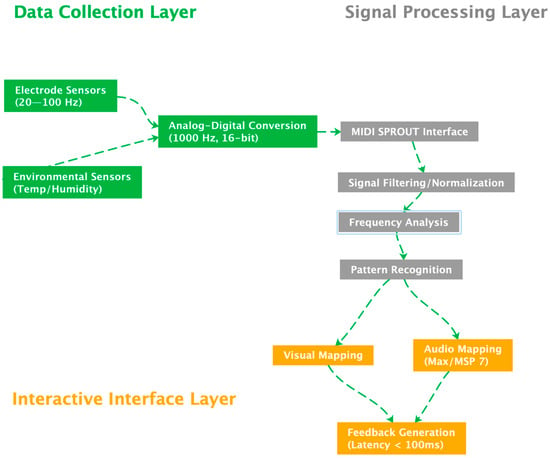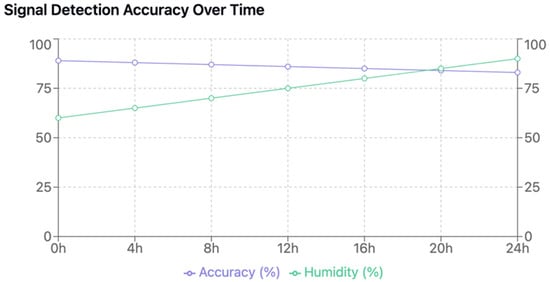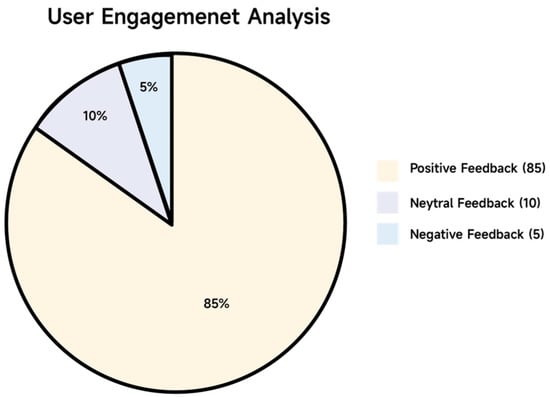Abstract
An innovative approach is explored to reconnect urban populations with nature through the integration of technology and artistic expression. In a case study of London’s Canary Wharf, environmental sensor data of sound and visual art were analyzed to create new pathways for human–plant interaction. By transforming plant biological data into accessible artistic experiences, interdisciplinary methods spanning environmental science, plant biology, and artistic practice can enhance ecological awareness and engagement. The synthesized approach in this study offers promising solutions for addressing the growing disconnect between urban communities and their natural environment.
1. Introduction
The unprecedented urbanization has created a critical disconnect between anthropogenic and natural systems, with urban residents spending approximately 90% of their time in artificial environments. This separation has led to a marked decline in ecological awareness and environmental stewardship, necessitating innovative approaches to rebuilding human–nature connections. Recent advances in plant neurobiology and bioacoustics have revealed sophisticated communication and sensing capabilities of botanical organisms, presenting novel opportunities for technological mediation of human–plant interactions [1,2,3,4,5,6]. Specifically, plant neurobiology and bioacoustics play a crucial role in bridging the gap between urban populations and natural ecosystems by enabling plants to “talk” to humans using real-time sensor data and AI-powered language models. This is achieved through a novel plant communication application that utilizes soil sensors to track moisture, temperature, and nutrient levels, with the data processed by the Gemini application programming interface (API) to provide natural language insights about the plant’s health and “mood” [7].
In this study, an innovative methodology is presented that bridges the urban nature divide through the synthesis of bioelectrical sensing technology and artistic expression. A three-layer system architecture is developed and implemented to capture, process, and translate plant conductivity fluctuations into real-time audiovisual feedback. The framework deploys high-precision electrode sensors capable of detecting minute conductivity variations within the range of 20–100 Hz with subsequent signal processing using Max/MSP 7 software for artistic interpretation.
The integration of bioelectrical sensing with artistic expression represents a methodological innovation in environmental interaction studies. This approach enables the following: (1) quantifiable measurement of plant responses to environmental stimuli and human interaction (by allowing plants to perform art through biosignals, this integration sheds light on the subjective perception of plants, a peripheral subject that rarely comes to people’s attention [8]); (2) real-time translation of botanical electrical activity into accessible artistic representations; and (3) the creation of interactive feedback loops between urban residents and plant life. By establishing an environmentally controlled space where viewers experience the plant-perceived natural environment, this integration fosters cross-species sensory experiences, enhancing our understanding of human–plant interactions in urban environments [8]. The research methodology synthesizes elements from plant neurobiology, interactive art, and environmental psychology to create a comprehensive framework for analyzing human–plant interactions in urban contexts.
2. Methods
2.1. Construction of Human-Plant Interaction System
The proposed human–plant interaction framework implements a sophisticated three-layer architecture that facilitates precise bioelectrical signal detection, processing, and interactive feedback generation. This hierarchical structure enables monitoring and interpretation of plant physiological responses while maintaining system scalability and operational reliability. Figure 1 is shown for details.

Figure 1.
System architecture.
2.1.1. Data Collection and Analysis
The foundational architecture of the system implements a sophisticated bioelectrical signal detection framework utilizing precision-engineered dual-point electrode sensors. These sensors, strategically positioned on specific plant tissue interfaces, facilitate the measurement of micro-scale conductivity fluctuations at the cellular level. Environmental factors such as temperature and humidity are continuously monitored to ensure optimal signal detection conditions [9].
The analysis of signal strength variations across diverse plant species reveals statistically significant differences in bioelectrical conductivity patterns, attributable to evolutionary adaptations in cellular structure and physiological characteristics. Notably, tropical plant specimens, characterized by well-developed vascular systems and elevated moisture content, consistently demonstrate superior signal conductivity (0.8–1.0 mS/cm). This enhanced conductivity presents marked contrast to xerophytic species, which exhibit substantially lower conductivity ranges (0.1–0.3 mS/cm), presumably due to their adapted water conservation mechanisms. These empirically observed variations necessitate the implementation of species-specific calibration protocols to ensure measurement accuracy and repeatability (Table 1).

Table 1.
Comparative analysis of signal strength across plant species.
2.1.2. Signal Processing Layer
The signal processing layer forms the core of the system, implementing a sophisticated flow from raw data capture to meaningful output. Using the MIDI SPROUT interface for initial signal conditioning, the system amplifies and filters the detected conductivity variations before passing them to Max/MSP 7 for advanced processing. Signal normalization follows a standardized algorithm that accounts for baseline variations and amplitude ranges, ensuring consistent output regardless of environmental conditions. This layer also incorporates real-time frequency analysis and pattern recognition to distinguish meaningful variations from background noise.
2.1.3. Interactive Interface Layer
The interactive interface layer transforms processed signals into engaging audiovisual feedback. Using Max/MSP 7, conductivity variations are mapped to sonic parameters, with changes in plant electrical activity directly influencing pitch, timbre, and rhythm. Simultaneously, these signals drive visual pattern generation, creating dynamic displays that reflect the plant’s response to environmental changes and human interaction. The system maintains a response latency below 100 mS/cm, ensuring immediate feedback that enhances the feeling of direct connection between participants and plants. Environmental data correlation is visualized along with the primary feedback, providing context for observed changes in plant activity.
2.2. Human–Plant Interaction System
After establishing the system’s technical architecture, this framework is implemented in real-world urban environments to evaluate its effectiveness in facilitating human–plant interactions. The three-layer architecture detection, processing, and interactive interface serve as the foundation for experimental installations across London’s Canary Wharf district. By translating the technical specifications into physical installations, the system’s performance and its impact on public engagement are tested under varying environmental conditions. The following section details how this theoretical framework was realized in practical applications, examining technical implementation and user interaction patterns.
2.2.1. Installation Sites
The experimental implementation centered on London’s Canary Wharf district was chosen for its unique combination of dense urban development and managed green spaces. Installation sites were selected to maximize public engagement while ensuring optimal technical performance and plant health. Urban green spaces such as those in Canary Wharf enhance public engagement and community well-being by improving mental and physical health, fostering social cohesion, and promoting a sense of belonging [10]. Key locations included high-traffic pedestrian zones, public gardens, and community gathering spaces, each chosen to represent different urban contexts and patterns of human–plant interaction.
2.2.2. Technical Setup
The technical infrastructure was designed for durability and reliability in outdoor urban conditions. Weather-resistant electrode sensors were installed on selected plants and connected to protected processing units housed in weatherproof enclosures. The audio system employed directional speakers mounted at optimal heights to create focused sound fields, while LED displays were positioned to maintain visibility while minimizing light pollution. According to practices for minimizing light pollution while ensuring visibility in urban LED display installations, rational urban design and scientific management techniques are essential [11]. Plant protection barriers were implemented to prevent damage while maintaining accessibility for intended interactions. Each installation point was equipped with environmental monitoring sensors to track temperature, humidity, and light levels, enabling correlation between environmental conditions and plant responses.
2.2.3. Interaction
The interaction design followed a carefully structured flow optimized for intuitive engagement. When visitors approach an installation, proximity sensors trigger initial audiovisual feedback, drawing attention to the interactive potential. This method enhances user engagement by allowing the users to influence the final visual effect as they move into the installation space, similar to how sound waves are visualized in an interactive audiovisual creation [12]. Direct touch interaction with the plant triggers the measurement of conductivity changes, which are immediately processed and transformed into real-time sonic and visual responses. This immediate feedback loop creates a sense of direct communication with the plant, while displays provide context about the interaction and environmental conditions. The system maintains continuous data logging of all interactions, enabling detailed analysis of engagement patterns and system performance over time.
- Human approach → plant detection;
- Touch interface → conductivity change;
- Signal processing → real-time response;
- Audiovisual feedback → public engagement.
3. Results
3.1. Experimental Design
Technical performance metrics demonstrated the system’s capabilities and areas needing refinement. The signal detection achieved 89% accuracy within the specified frequency range, with response times averaging 2.3 mS/cm for immediate feedback generation. Conductivity measurements remained stable in a range of 0.1–1.0 mS/cm, while touch response detection maintained reliability of 85% across varied environmental conditions. However, signal processing occasionally showed inconsistencies during peak usage periods, suggesting the need for improved data handling algorithms and enhanced processing capacity to maintain consistent performance under high load (Figure 2).

Figure 2.
Signal detection accuracy and environmental conditions.
User engagement data revealed significant public interest and interaction with the installations. Daily interactions exceeded 200 visitors across all sites, with an average engagement time of 4.5 min per interaction. A 73% increase in reported environmental awareness among participants indicates the system’s effectiveness in promoting nature connection. The positive feedback rate was 85%, highlighting user appreciation for the interactive experience, though feedback also indicated a desire for more varied and nuanced audiovisual responses to different types of plant interactions (Figure 3).

Figure 3.
User engagement results.
3.2. Experimental Results
The experimental results suggest several areas for technical enhancement to deepen the interactive experience. Current limitations in the Max/MSP 7 signal processing create occasional latency in translating subtle conductivity changes into audiovisual feedback. Users required more diverse sound mappings and visual patterns to reflect different interaction intensities and durations. Additionally, the system benefits from implementing machine learning algorithms to recognize and respond to patterns in human–plant interactions, potentially creating personalized and engaging experiences. These improvements enhance the system’s capability to convey the nuanced “language” of plant responses, making the interaction more meaningful and educational for urban residents.
4. Conclusions
The present study has demonstrated the potential of integrating art and technology to forge stronger connections between urban dwellers and the natural world of plants. The developed system in this study leverages sophisticated bioelectrical sensing and artistic expression and has proven to be accurate in detecting and processing signals, thereby providing a robust platform for human–plant interaction.
The significant improvements in user engagement and environmental awareness, as evidenced by the experimental results, underscore the effectiveness of the system in bridging the urban–nature divide. The system offers a novel perspective on ecological perception and presents a practical solution to the current ecological crisis by fostering a deeper understanding and appreciation of plant life among urban residents.
It is still necessary to enhance the capabilities of the developed system and expand its applications. The range of frequency detection is required to capture a wider array of plant responses and refine signal processing algorithms to improve the accuracy and responsiveness of the system. Long-term engagement patterns need to be explored to understand the sustained impact of such interventions on public behavior and environmental consciousness.
The fusion of art and technology exemplified in this study fosters human–plant connections in urban environments. By refining and expanding the system, a more sustainable and eco-conscious urban future can be ensured.
Funding
This research received no external funding.
Institutional Review Board Statement
Not applicable.
Informed Consent Statement
Informed consent was obtained from all subjects involved in the study.
Data Availability Statement
Data are contained within the article.
Conflicts of Interest
The authors declare no conflicts of interest.
References
- Morton, T. The Ecological Thought; Harvard University Press: Cambridge, MA, USA; JSTOR: New York, NY, USA, 2010; Available online: https://books.google.co.il/books?id=KE32DwAAQBAJ (accessed on 28 January 2025).
- Simard, S.E. Finding the Mother Tree: Discovering the Wisdom of the Forest; Knopf Publishing: New York, NY, USA, 2022; ISBN 978-0525656098. [Google Scholar]
- Tompkins, P.; Bird, C. The Secret Life of Plants, 1st ed.; Harper & Row: New Delhi, India, 1973. [Google Scholar]
- Oe, H.; Yamaoka, Y.; Weeks, M. Technobiophilia: Nature and human interactions in the digital age. Cogent Arts Humanit. 2022, 9, 2068823. [Google Scholar] [CrossRef]
- Gagliano, M.; Mancuso, S.; Robert, D. Towards understanding plant bioacoustics. Trends Plant Sci. 2012, 17, 323–325. [Google Scholar] [CrossRef] [PubMed]
- Baluška, F.; Mancuso, S. Plant neurobiology: From stimulus perception to adaptive behavior of plants, via integrated chemical and electrical signaling. Plant Signal. Behav. 2009, 4, 475–476. [Google Scholar] [CrossRef] [PubMed][Green Version]
- Agarwal, K.; Ananthanarayanan, S.; Srinivasan, S.; Abirami, S. Enhancing IoT based Plant Health Monitoring through Advanced Human Plant Interaction using Large Language Models and Mobile Applications. arXiv 2024, arXiv:2409.15910. [Google Scholar]
- Hu, Y.; Chou, C.; Kakehi, Y. Lucid Dream: Sensing and Artistic Representation of Plant-Nature Interaction Based on Plants Biosignals. In Proceedings of the International Symposium on Electronic Art ISEA2023, Paris, France, 16–21 May 2023. [Google Scholar]
- Tahyudin, I.; Rozaq, H.A.A.; Nambo, H. Machine Learning Analysis for Temperature Classification using Bioelectric Potential of Plant. In Proceedings of the 2022 6th International Conference on Information Technology, Information Systems and Electrical Engineering (ICITISEE), Yogyakarta, Indonesia, 13–14 December 2022; pp. 465–470. [Google Scholar]
- Paniccià, M.; Acito, M.; Grappasonni, I. How outdoor and indoor green spaces affect human health: A literature review. Ann. Ig. Med. Prev. Comunita 2024. Online ahead of print. [Google Scholar]
- Li, K. Environmental Aspects of Urban Lighting. Acad. J. Sci. Technol. 2024, 9, 271–275. [Google Scholar] [CrossRef]
- Konstas, S. Audiovisual installation: Interactive imprinting of sound in water. In Proceedings of the Electronic Visualisation and the Arts (EVA 2012), London, UK, 10–12 July 2012. [Google Scholar]
Disclaimer/Publisher’s Note: The statements, opinions and data contained in all publications are solely those of the individual author(s) and contributor(s) and not of MDPI and/or the editor(s). MDPI and/or the editor(s) disclaim responsibility for any injury to people or property resulting from any ideas, methods, instructions or products referred to in the content. |
© 2025 by the author. Licensee MDPI, Basel, Switzerland. This article is an open access article distributed under the terms and conditions of the Creative Commons Attribution (CC BY) license (https://creativecommons.org/licenses/by/4.0/).